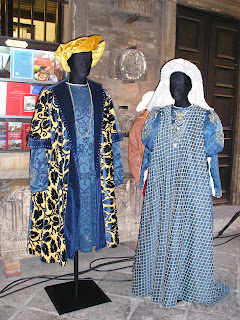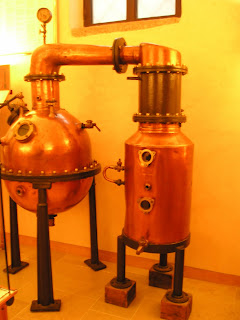As with Ferrara, I had very specific reasons for wanting to go to Vicenza. Yes, it is a beautiful city, with wonderful architecture, gorgeous art and interesting food. More importantly for me, though, home to the Teatro Olimpico, which I wrote about in my master’s thesis and therefore absolutely had to visit. I won’t bore you right now with a lecture on why the Teatro Olimpico is important. I can’t promise that I won’t bore you with it later, though.
I’d mentioned at school that I was thinking of going to Vicenza on Sunday, and my fabulous friend B. suggested that we go together—she had a car, and could drive us. Which would be fantastic, not just for the company, but because traveling by car gives so much more flexibility. We planned to set out for Vicenza around noon, and try to squeeze in excursions to Bassano del Grappa and Marostica, where there was to be a live chess game in the castle square at 9pm: performers in full medieval dress, and the “knights” actually riding horses! B. had heard about it from one of the American exchange students in her class, who was going with the others from her university.
A couple times on this trip I’d thought about renting a car. The regional trains are very inexpensive, but can be slow, and then you’re tied down to schedules and stations and so forth. There’s never the autonomy of the automobile. But I couldn’t bring myself to do it. For one thing, it can get expensive; I would find myself reckoning how many books I could buy for a weekend’s car rental and gas, and decide I’d rather have the books, and the time to read them on the train. Also, I’ve never learned how to drive stick shift; I’d have to pay more and reserve farther ahead to get an automatic. But the real reason I never thought seriously about renting a car in Italy is that I’m just plain scared to drive here! Italian drivers operate by their own peculiar set of rules, which I’m sure makes sense to them, but is alien to me, and I’m just too much of a chicken to venture onto their roadways.
In fact, Sunday was the first time this trip that I’d been a passenger in a car other than a taxi, and the first time I’d paid any attention to directions and signage. I was a little baffled by it all, but B. did brilliantly.
We arrived in Vicenza in the gloriously sunny midday, and ambled through the historic center, taking detours off the Corso Palladio to wander into the piazzas as we slowly wended our way toward the Teatro Olimpico.
You’re going to see the name Palladio a lot in this post, so let me give you the short-short biography: Andrea Palladio (1508-1580) was the preeminent neoclassical architect of the Renaissance, a native of the Veneto. The streets of Vicenza are filled with Palladio buildings, and they are fantastic. There is beautiful and interesting architecture all over Italy, but Vicenza, with its bright gleaming palazzi lining the long avenues, just might win the prize.
Along the way we saw a sign for a modern design exhibit inside a Palladian palazzo—lots of unusual and attractive objects, and I loved seeing these twenty-first century artifacts, sharp-edged or globular, stark black and white and metal with the occasional blaring neon, balanced on these massive oak tables with Baroque oil paintings fanned out along the walls behind them. You wouldn’t think it would work, but it does.
There was an outdoor antiques market, with furniture and paintings and Venetian glassware and vintage jewelry and about a million things I wanted to take home with me if I’d had room in my suitcase or my budget.
In the middle of the Piazza dei Signori was an enormous painted wooden sculpture, resembling a fountain with a water wheel in the middle. It is called the Rua (wheel), which was used in a procession to celebrate the day of Corpus Domini in early September. A form of the Rua was carried in the streets of Vicenza from the fifteenth century until the twentieth; what we saw on Sunday was a reconstruction of the eighteenth-century Rua. The original had been destroyed in WWII and the replica was made in 2007. For two weeks after Corpus Domini, the Rua is on display in the piazza.
There also happened to be a cultural exhibition, sort of a fair of medieval arts and crafts. The participants were all dressed in costumes. There were booths offering snacks: grilled salame slices served in little buns (good), and apple fritters (excellent).
In others, artisans demonstrated their crafts, and everywhere, goods were for sale.
In a little gallery was a display of costumes, done in the style, we were told, of fifteenth-century Venice:
But before we got to the Teatro Olimpico, my camera batteries died! (And they were only two days old. Yeah, I definitely need to get a new camera.) I didn’t know if photos would be allowed inside the theater and museum, but there was no way I could go in unprepared. Unfortunately, it was still lunchtime and all the shops, even the tabaccherie, would be closed until 3:30. So B. and I turned back up the Corso Palladio, visited the beautiful Duomo and had a lovely, leisurely coffee until the stores reopened. But after I got my batteries I was distracted by more photo opportunities—now there were whole parades of Vicenza’s citizens in fifteenth-century costume! There were teenagers carrying banners and drums, adults dressed as noblemen and women (mostly men).
There were still the folks working the fair booths. In the courtyard of a palazzo a performer was juggling fire, I think—I was too short to see over the crowd, but whatever he was doing, there was a lot of smoke and flames and the spectators were hooked. There was a troupe of street performers:
And there was even a band of musicians wandering around the center of town. (Sadly, when they wandered by us I was camera-less.) Their costumes were not so exciting, but they played period instruments, and played them pretty well. Oddly, they played a bunch of English tunes—“Greensleeves,” “Past-time with good company”—which surprised me since there’s such a wealth of Italian music from the fifteenth and sixteenth centuries, and the whole point of this fair was to celebrate local cultural history. But who am I to criticize? It was fabulous to sit out in the sunshine, drinking coffee and chatting and people-watching and listening to a band play…
So fabulous, in fact, that when we finally got back to the Teatro Olimpico it had already closed for the day! I was a little sad, but honestly, I was also a little museumed-out after the long day in Ferrara, so I didn’t mind. I had one last Saturday left, the day before my flight home, and so I could make a quick trip to Vicenza that morning to see the theatre. But I took a couple quick snaps of the exterior:
From Vicenza we took a beautiful drive to the small, picturesque town of Bassano del Grappa, which is famous for—you guessed it—grappa. We parked facing this gorgeous church:
My guidebook, which devoted less than a page to Bassano del Grappa, did not even mention the Duomo, figuring that visitors were more interested in beverages than architecture.
Since B. was driving, she made me the designated drinker, and steered us toward Nardini, one of the premier grappa manufacturers. The tasting room was packed, but as we edged slowly up toward the bar, we realized that pretty much everyone in there was local—hardly another tourist, a welcome surprise. They were nearly all ordering the same thing, little tumblers of a deep brown liquid, slightly fizzy, with a lemon slice floating on top. “What is that?” inquired B. of a customer. “A mezzo e mezzo,” he replied, then squeezed himself through the crowd and disappeared out the door. Half and half of what, we wondered? Once back online, I did a little research and discovered that a mezzo e mezzo is made of equal parts Nardini Rabarbaro (grain alcohol infused with rhubarb) and Nardini Rosso (grain alcohol and sweet vermouth), topped off with soda water.
But since this was my first time, I was not going to bother with a cocktail, but take my grappa straight up. And it actually was my first grappa. I think I may have had it once in a caffè corretto, but you can’t taste it that way. B. advised me to sample the riserva, aged 15 years. So I did. And it was wonderful. Smooth, hot, the pale color of amber. The location, on a bridge designed by Palladio with a stunning view of the Dolomites, didn’t hurt either.
Across the way from Nardini is the Poli Museo del Grappa. Yes, a museum devoted to grappa. Do you know how many kilos of grapes it takes to produce a single bottle of grappa? I would tell you, but I forgot to write it down. It was a boggling number, I can tell you that. And check out these beautiful antique stills:
This one was built according to a 1565 design:
A little after 8PM we arrived in Marostica to see if we could find the other students and try to see the chess game. I expected a public spectacle like we’d just seen in Vicenza: out in an open square where anyone could watch. In fact, it was a formal performance. Bleachers had been erected in the courtyard of Marostica’s imposing medieval fortress, and a temporary wall was put up so that those who hadn’t paid for their seats wouldn’t be able to see anything. The show was nearly sold out; all that remained were floor seats, for €45 each, which was a bit much for us. B. and I would have to content ourselves with reading about it. So we headed back to Verona and finished up the night with a delicious dinner at the best pizzeria in town.


















No comments:
Post a Comment